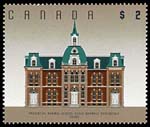Last Updated April 25, 2002 by Robin Harris
First published in the May 1995 Buffalo, the monthly publication of The Winnipeg Philatelic Society.
This will be an ongoing series on modern Canadian stamps, primarily the definitives, providing tips that I have encountered over the past thirty years of studying literally hundreds of thousands of stamps. The topics will lean toward the specialized but provide a good education for the novice collector as well.
Many collectors are obsessed with only collecting mint, never hinged stamps purchased either directly from the post office or from their favourite stamp dealer. That is certainly fine. However, there is an entire world of used material out there that is just waiting to offer hours of enjoyment through study.
I define philately as the study of stamps. I am always amazed at the depth (or lack thereof) with which some philatelists (and I use the term loosely) study their stamps. I love the hunt for a new variety on a modern Canadian stamp a perforation change, constant plate variety, printing change, tagging error, etc. Through these articles I hope you sense some of the thrill I enjoy while hunting for varieties through mixtures of used stamps.
Study Tip #1: A change in printer usually results in a distinguishable variety (thus, cataloguable, therefore, definitely collectable).
 Take the current $1 and $2 Architecture stamps (Court House in Yorkton (blue-grey) and the Provincial Normal School in Truro (light brown), respectively). These were first issued Feb 21, 1994, replacing the $1 Runnymede Library (blue) and $2 Railway Station (orange) stamps.
Take the current $1 and $2 Architecture stamps (Court House in Yorkton (blue-grey) and the Provincial Normal School in Truro (light brown), respectively). These were first issued Feb 21, 1994, replacing the $1 Runnymede Library (blue) and $2 Railway Station (orange) stamps.
These Feb 21, 1994 issues were printed by Leigh-Mardon Pty Ltd of Australia. I'm guessing that large quantities of these were used by the public because a second printing was released less than one year later Feb 20, 1995 (ok, it is only short by one day, but that is still less than one year). Since Leigh-Mardon is no longer printing Canadian stamps, the new stamps had to be printed by another firm, the current printer of Canadian stamps, Canadian Bank Note Co. Ltd of Ottawa.
The Spring 1995 Collections of Canada stamp catalogue from Canada Post only mentioned a change in printers. I quickly ordered these from Antigonish, NS to study them in detail. When they arrived I immediately checked the original issue against the reprints for a colour or other detail change in the design (the first three Architecture stamps issued in 1989 had two different printers with discernable design changes, as I discussed in the October 1992 Buffalo).
Study Tip #2: when looking for new varieties, always check the perforations first.
 The detailed checking of the colour and design produced no differences. Darn it all anyway - can't two different printers come up with different stamps? How is the used-stamp collector going to tell the difference between the two printings? On a whim I checked the perforations (the first and easiest printing change to check) they were different! I can't believe I spent at least three minutes checking the stamp's details for a design change sometimes we forget to check the easiest things first.
The detailed checking of the colour and design produced no differences. Darn it all anyway - can't two different printers come up with different stamps? How is the used-stamp collector going to tell the difference between the two printings? On a whim I checked the perforations (the first and easiest printing change to check) they were different! I can't believe I spent at least three minutes checking the stamp's details for a design change sometimes we forget to check the easiest things first.
The first printing of the current $1 and $2 Architecture stamps had a perforation of 14 1/2 x 14 the new printing has a perforation of 13 1/3 x 13. A perforation change guarantees that the reprinted stamps will be catalogued, usually with a minor letter.
PS. Of all of the high-value definitives ($1 and over) issued since 1967 (a total of 15) until now (mid 1995), all but 4 exist with at least 2 easily identifiable varieties I repeat, 11 of the last 15 $1 and over definitives require studying to classify their collectable varieties that is one of the thrills of collecting used stamps.
PSS. Did you know that the 43c Flag definitive (Scott #1359) has two different perforation varieties? It should be noted that both the sheet and booklet stamps are affected. Once again, it was a change in printers (involving Leigh-Mardon of Australia) that caused the perforation changes.
© 1995-2017, 2018 Robin Harris
Adminware is a trademark of Adminware Corporation.
